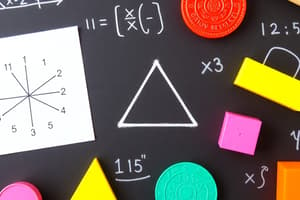Podcast
Questions and Answers
Which property states that $a + b = b + a$?
Which property states that $a + b = b + a$?
- Distributive property
- Associative property
- Commutative property (correct)
- Identity property
What is the term used to describe a function that can be expressed as $y = ax^2 + bx + c$?
What is the term used to describe a function that can be expressed as $y = ax^2 + bx + c$?
- Linear function
- Polynomial function (correct)
- Logarithmic function
- Exponential function
In the context of trigonometry, what does the sine of an angle represent?
In the context of trigonometry, what does the sine of an angle represent?
- Opposite side over hypotenuse (correct)
- Adjacent side over opposite side
- Adjacent side over hypotenuse
- Hypotenuse over opposite side
Which of the following is NOT a type of probability distribution?
Which of the following is NOT a type of probability distribution?
What does the concept of 'limits' in calculus help to determine?
What does the concept of 'limits' in calculus help to determine?
What type of matrix has the same number of rows and columns?
What type of matrix has the same number of rows and columns?
Which of the following operations does not belong to set theory?
Which of the following operations does not belong to set theory?
Which of the following is a fundamental theorem of calculus?
Which of the following is a fundamental theorem of calculus?
Flashcards are hidden until you start studying
Study Notes
Key Concepts in Mathematics
-
Arithmetic
- Basic operations: addition, subtraction, multiplication, division
- Properties: commutative, associative, distributive
-
Algebra
- Variables and constants
- Expressions and equations
- Solving linear equations and inequalities
- Functions: linear, quadratic, polynomial, exponential, logarithmic
-
Geometry
- Types of shapes: triangles, quadrilaterals, circles, etc.
- Theorems: Pythagorean theorem, properties of congruence and similarity
- Surface area and volume calculations
- Coordinate geometry: distance formula, midpoint formula, slope
-
Trigonometry
- Definitions: sine, cosine, tangent and their reciprocals
- Unit circle: angles and corresponding coordinates
- Trigonometric identities: Pythagorean, angle sum/difference, double angle formulas
-
Calculus
- Limits and continuity
- Derivatives: definition, rules (power, product, quotient, chain)
- Integrals: definite and indefinite integrals, fundamental theorem of calculus
- Applications: optimization, area under curves
-
Statistics
- Descriptive statistics: mean, median, mode, range
- Probability concepts: events, outcomes, conditional probability
- Distributions: normal, binomial, Poisson
- Hypothesis testing and confidence intervals
-
Logic and Set Theory
- Logical statements: true, false, negation
- Set operations: union, intersection, difference
- Venn diagrams for visual representation of sets
-
Number Systems
- Natural numbers, whole numbers, integers, rational numbers, irrational numbers
- Prime and composite numbers
- Real and complex numbers
-
Discrete Mathematics
- Graph theory: vertices, edges, paths, cycles
- Combinatorics: permutations, combinations, binomial theorem
- Algorithms and their complexities (big O notation)
-
Matrices and Determinants
- Types of matrices: square, row, column, identity
- Operations: addition, subtraction, multiplication
- Determinants and applications in solving linear equations
Study Tips
- Practice regularly with problem sets to reinforce concepts.
- Break complex topics into smaller segments for easier understanding.
- Utilize visual aids like diagrams and graphs for geometrical concepts.
- Form study groups to discuss and solve problems collaboratively.
Arithmetic
- Basic arithmetic involves addition, subtraction, multiplication, and division.
- Properties of arithmetic include commutative, associative, and distributive.
Algebra
- Algebra utilizes variables and constants to represent unknown or changing values.
- Equations and expressions involve these variables and constants, forming relationships between them.
- Solving linear equations and inequalities involves manipulating equations to isolate the unknown variable.
- Functions in algebra describe relationships between input and output values.
- Common types of functions include linear, quadratic, polynomial, exponential, and logarithmic functions.
Geometry
- Geometry explores the shapes of objects and their properties.
- Triangles, quadrilaterals, circles, and other geometric shapes are studied for their unique characteristics.
- Theorems such as the Pythagorean theorem are fundamental tools for understanding geometric relationships.
- Congruence refers to shapes having the same size and shape, while similarity refers to shapes with proportionally equivalent sides.
- Geometric calculations include finding surface area and volume for different three-dimensional shapes.
- Coordinate geometry uses coordinates to represent points and shapes on a plane, and includes concepts like the distance formula, midpoint formula, and slope.
Trigonometry
- Trigonometry focuses on the relationships between angles and side lengths in triangles.
- Key trigonometric functions include sine, cosine, tangent, and their reciprocals.
- The unit circle provides a visualization of angles and their corresponding coordinates, useful for understanding trigonometric values.
- Trigonometric identities, like the Pythagorean identity and angle sum/difference formulas, simplify calculations and help solve equations.
Calculus
- Calculus is the study of change and motion.
- Limits and continuity form the foundation of calculus, defining the behavior of functions at specific points or over intervals.
- Differentiation calculates the rate of change of a function, represented by its derivative.
- Rules for finding derivatives of various functions are essential for understanding their properties.
- Integration is the inverse operation of differentiation, allowing for calculation of areas under curves and volumes of solids.
- The fundamental theorem of calculus connects differentiation and integration, providing a powerful tool for solving problems.
- Applications of calculus include finding maximum and minimum values of functions (optimization), calculating areas and volumes, and modeling real-world phenomena.
Statistics
- Statistics involves collecting, analyzing, and interpreting data to draw conclusions and make predictions.
- Descriptive statistics summarize data using measures like mean, median, mode, and range.
- Probability theory deals with the likelihood of events, considering factors like outcomes, conditional probability, and events.
- Common probability distributions include normal, binomial, and Poisson distributions, each with its own properties and applications.
- Hypothesis testing and confidence intervals are used to analyze data and make inferences about population characteristics based on samples.
Logic and Set Theory
- Logic deals with reasoning and truth values, analyzing statements into true or false categories.
- Set theory studies collections of objects called sets and their relationships.
- Set operations, including union, intersection, and difference, combine or compare sets.
- Venn diagrams visually represent sets and their relationships, aiding in understanding logical operations.
Number Systems
- Number systems categorize numbers based on their properties and relationships.
- Common number systems include natural numbers, whole numbers, integers, rational numbers, and irrational numbers.
- Prime and composite numbers are distinguished based on their divisibility by other numbers.
- Real and complex numbers encompass all numbers, including both rational and irrational numbers, along with imaginary numbers that involve the square root of -1.
Discrete Mathematics
- Discrete mathematics focuses on structures that can be counted or separated.
- Graph theory studies networks or relationships between objects represented as vertices and edges.
- Combinatorics involves counting and arranging objects, including concepts like permutations, combinations, and the binomial theorem.
- Algorithms, sequences of instructions for solving problems, are analyzed in terms of complexity using big O notation, which estimates the time and space resources needed.
Matrices and Determinants
- Matrices are rectangular arrays of numbers, organized in rows and columns.
- Types of matrices include square matrices, rows, columns, and identity matrices, each with specific properties and applications.
- Operations on matrices include addition, subtraction, and multiplication, with unique rules for each operation.
- Determinants, calculated from square matrices, provide valuable information about the matrix's structure and invertibility, and are used in solving systems of linear equations.
Studying That Suits You
Use AI to generate personalized quizzes and flashcards to suit your learning preferences.




